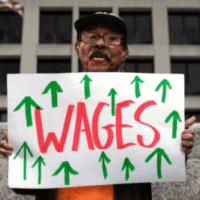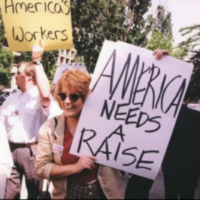In November, Nebraskans will have an opportunity to raise the state’s minimum wage. Under Initiative 433 the state’s minimum wage would gradually increase to $15 by 2026, with annual cost of living adjustments thereafter. The measure would benefit nearly 150,000 workers and strengthen Nebraska’s economy.
Minimum wage increases are a tried-and-true approach to boosting workers’ paychecks without negative effects, as three decades of economic research demonstrates.
Minimum wage increases are a tried-and-true approach to boosting workers’ paychecks without negative effects, as three decades of economic research demonstrates. Businesses benefit from increased consumer spending, lower employee turnover, increased productivity, and improved customer service.
Raising Nebraska’s minimum wage benefits businesses because it increases workers’ ability to spend more as customers
Nebraska’s minimum wage is currently $9.00 per hour,[1] which amounts to $18,720 in pre-tax earnings for year-round, full-time workers. Under Initiative 433, Nebraska’s minimum wage would gradually increase over four years—first to $10.50 per hour on Jan. 1, 2023, and then $12 per hour in 2024, $13.50 per hour in 2025, and $15 per hour in 2026. Starting in 2027, the state minimum wage would be adjusted annually to account for increases in the cost of living.[2]
According to the Economic Policy Institute, a $15 minimum wage in Nebraska would benefit nearly 150,000 workers (17 percent of the state’s workforce). On average, their annual earnings would increase by $2,100, which amounts to over $278 million in additional earnings for all affected workers.[3]
Raising the minimum wage to $15 per hour will put more money in the pockets of the customers of Nebraska businesses. Workers in underpaid jobs are, out of necessity, most likely to spend any additional money they make. Consequently, raising the minimum wage would boost consumer spending as workers and their families buy goods and services from local businesses across Nebraska.
Raising the minimum wage would benefit businesses by reducing employee turnover, increasing productivity, and improving customer service
Underpaid industries are plagued by high turnover rates—a trend that predates the pandemic (Table 1). Data from the U.S. Bureau of Labor Statistics shows that in 2021, turnover rates in three underpaying industries (leisure and hospitality, accommodation and food services, and retail trade) were among the highest, reaching 84.9 percent, 86.3 percent, and 64.6 percent, respectively. By comparison, the average turnover rate for all industries in 2021 was 47.2 percent.[4]
| Table 1. Annual turnover rate by selected industry, 2017-2021 | |||||
| Industry | 2017 | 2018 | 2019 | 2020 | 2021 |
| Retail Trade | 53.8 | 58.1 | 58.4 | 69.6 | 64.6 |
| Leisure and Hospitality | 74.2 | 77.1 | 79.3 | 129.8 | 84.9 |
| Accommodations and Food Service | 72.4 | 75.1 | 79.1 | 130.2 | 86.3 |
| Average for all industries | 43.3 | 44.5 | 45.1 | 56.8 | 47.2 |
| Source: U.S. Bureau of Labor Statistics, Job Openings and Labor Turnover Table 16: Annual total separations rates by industry and region, not seasonally adjusted, last modified March 10, 2022. https://www.bls.gov/news.release/jolts.t16.htm. | |||||
Turnover rates are affected by worker dissatisfaction.[5] A Pew Research Center survey found that the top three reasons why workers quit their jobs in 2021 are low pay (63 percent), no opportunities for advancement (63 percent), and feeling disrespected at work (57 percent).[6]
As summarized in the Wall Street Journal, a “large body of research…suggests that raising wages leads to lower employee turnover and better customer service, which generally correlate with higher sales and lower expenses,” and “stemming turnover, in particular, can save companies a lot of money.”[7]
Turnover is costly for businesses. An analysis of case studies published between 2000 and 2020 found that the median cost of turnover represented 23.5 percent of an employee’s annual wage.[8]
Turnover costs are even higher when more indirect costs are included in the measurement. For example, an in-depth study of the supermarket industry found that the annual cost of turnover exceeded the industry’s total annual profit by 40 percent. The research factored in direct costs such as advertising, screening, training, and new employee processing. It measured indirect costs such as errors, product damage, and improper use of equipment. It also analyzed the “large and critical cost element” of lost customers due to employee turnover, as customers are irritated by new and inexperienced replacement employees, to the point of taking their business elsewhere.[9]
The large staffing company, Adecco, observes, “There’s plenty of research that shows the correlation between low wages and low productivity (and lack of employee engagement).” They note that “some lower-paying companies actually spend more than some higher-paying companies when it comes to workforce management. Why? Because the lower-paying companies have higher turnover costs in the form of job ads, onboarding, training, and opportunity costs. Not to mention, poor culture and productivity issues.” Looking more closely at the impact of higher turnover, Adecco’s data found that “50% of that turnover occurred within the first 45 days of a new hire starting a job. That’s very little time for an organization to see any ROI [Return on Investment] from their hires before losing them due to poor wages.”[10]
Discussing the high cost of underpaying workers, a Harvard Business Review article compared the practices of Costco with Wal-Mart and Sam’s Club. It found that while Costco spent significantly more money on wages and benefits than its low-paying competitors, the company had “unusually low” turnover and, overall, “one of the most loyal and productive workforces in all of retailing.”[11]
Extensive research shows that higher wages are associated with greater employee productivity and performance.[12] As a Peterson Institute for International Economics report explained, “Economists have long argued that increases in worker pay can lead to improvements in productivity—indeed, that it can actually be profitable to pay workers higher wages.”[13] The authors highlighted voluminous evidence in the economic literature finding that, among other things:
- Higher wages “motivate employees to work harder;”
- Higher wages “attract more capable and productive workers;”
- Higher wages “enhance quality and customer service;”
- Higher wages “reduce disciplinary problems and absenteeism;”
- Firms with higher wages “need to devote fewer resources to monitoring;”
- Workers “excessively concerned about income security perform less well at work;”
- Higher wages “are associated with better health—less illness and more stamina, which enhance worker productivity.”[14]
The authors further observe that, “All of these positive effects may interact to yield even larger aggregate effects, as the productivity of one worker often raises the productivity of their coworkers.”[15]
The benefits of increasing the minimum wage are especially important for small businesses, as the Business for a Fair Minimum Wage report, Raising the Minimum Wage to $15 Helps Small Business, observes: “For small businesses to survive and thrive in competition with large corporations and online companies with increasingly fast delivery, they have to give customers a reason to shop at their store and keep buying from them. And that depends heavily on customer service, which depends heavily on employees.” With livable wages, employees can afford to stay with the business, “develop better understanding of customers and help businesses innovate and keep up with what customers want.”[16]
Extensive economic research shows that states can increase the minimum wage without negative employment effects
Nebraska last raised its minimum wage through a November 2014 ballot initiative. The state minimum wage increased to $8.00 in 2015 and $9.00 in 2016, the level it remains today despite rising living costs. Nebraska’s unemployment rate was lower in 2017 (3.0 percent), after the 2015 and 2016 minimum wage increases, than it was in 2014 (3.3 percent) before the increases took effect.[17] Nebraska’s experience of implementing minimum wage increases without negative employment effects reflects the larger picture of minimum wage increases across the United States.
Three decades of extensive economic research overwhelmingly conclude that states can increase their minimum wage without reducing employment.[18]
In 2010, the Review of Economics and Statistics published the most methodologically sophisticated study of a new wave of minimum wage studies, “Minimum Wage Effects Across State Borders.” The study carefully analyzed minimum wage impacts across state borders by comparing employment patterns in more than 250 pairs of neighboring counties in the U.S. that had different minimum wage rates between 1990 and 2006. The study found no adverse employment effects, and it found no evidence that higher minimum wages pushed businesses across the state line.[19]
In a 2013 report, Why Does the Minimum Wage Have No Discernible Effect on Employment?, the Center for Economic and Policy Research spotlighted two meta-studies (studies of studies) analyzing extensive research conducted since the early 1990s. Those meta-studies conclude that “the minimum wage has little or no discernible effect on the employment prospects of low-wage workers.” The report also explored varied means of adjustment that offset minimum wage increases, such as the increased spending power of workers, increased worker productivity, and “reductions in labor turnover, which yield significant cost savings to employers.”[20]
A 2017 study examined state minimum wages from 1979 to 2016 using a novel approach (“bunching method”) that compares the number of jobs in various wage categories (rather than total employment) prior to and following a minimum wage increase. The study found that jobs were not adversely impacted. The researchers concluded that, “on average, the number of missing jobs paying below the new minimum during the five years following implementation closely matches the excess number of jobs paying just above minimum. This leaves the overall number of low-wage jobs essentially unchanged, while raising average earnings of workers below those thresholds.”[21] As Jared Bernstein, currently a member of the White House Council of Economic Advisers, put it, “the researchers find that jobs largely just shift from around the old wage to around the new wage.”[22]
In a 2018 article for the Washington Post, Bernstein looked at employment trends overall and in three underpaid sectors—retail, leisure and hospitality, and food services—among states that raised their minimum wages between 2013 and 2017 and states that did not raise their wage floors. He found that, both “overall and in the lower-wage sectors, job growth was slightly faster in states that raised their wage floors and unemployment fell a bit more.”[23] Among his findings:
- Total employment grew 10.1 percent in states with minimum wage increases and 8.2 percent in states with no increases.
- Retail trade employment grew 6.0 percent in states with increases and 4.9 percent in states with no increases.
- Leisure and hospitality employment grew 16.3 percent in states with minimum wage increases and 14.5 percent in states with no increases.
- Employment in food services (a subset of leisure and hospitality) grew 17.2 percent in states with minimum wage increases and 15.4 percent in states with no increases.[24]
A 2019 study published in the Quarterly Journal of Economics analyzed the effects of 138 state-level minimum wage increases between 1979 and 2016. When comparing employment levels in states that raised their minimum wages with states that did not, the authors found that “the overall number of low-wage jobs remained essentially unchanged over the five years following the increase.” They also found “no evidence of disemployment when we consider higher levels of minimum wages.”[25] As study co-author Arindrajit Dube summed it up, “Understandably, jobs paying below the minimum decreased—since wages rose. But at least as many jobs were added at the new, higher wage—meaning jobs were upgraded, not destroyed. All told, the number of low wage jobs barely budged. This finding held when we looked at populations of special concern—people with fewer educational credentials, for instance, or young workers. The finding held, as well, even when the minimum wage was set at a fairly high rate compared with the state’s median wage (the highest being around 60 percent of the median wage).”[26]
The 2020 Institute for Research on Labor and Employment study, Are Minimum Wage Effects Greater in Low-Wage Areas?, examined the impact of minimum wage changes in lower wage counties throughout the United States (2004-2017). It found no negative employment effects even when the minimum to median wage ratio reached as high as 82 percent. Moreover, the study found no adverse effects on weekly hours or annual weeks worked. Nor did it find “negative employment effects among women, blacks and/or Hispanics,” populations disproportionately represented among minimum wage workers.[27]
A November 2021 study by the Center for American Progress comparing states analyzed the impact of higher minimum wages on employment in the leisure and hospitality industry in the wake of the COVID-19 pandemic. It found that “employment in the predominantly low-wage leisure and hospitality industry has recovered faster in states that guarantee better pay for low-wage workers.”[28]
Businesses Support Raising the Minimum Wage
Polls show that business owners and executives support raising the minimum wage at the state and federal level. A revealing 2016 survey of 1,000 business executives across the country, commissioned by the Council of State Chambers and conducted by the firm run by longtime Republican pollster Frank Luntz, found that 80 percent of respondents supported raising their state’s minimum wage. Only eight percent opposed it. Twelve percent were neutral.[29]
Hundreds of Nebraska businesses have signed the Nebraska Business for a Fair Minimum Wage Statement in support of Initiative 433.[30] “Raising the minimum wage is a win/win for businesses and workers,” said signer Dave Titterington, owner of Wild Bird Habitat Stores in Lincoln and Omaha. “When you pay employees a living wage, they’re happier, they’re more dedicated, and they’re more productive. And raising the minimum wage will enable workers to spend more at local businesses all across Nebraska.”[31]
Conclusion
Raising the minimum wage would lift the incomes of nearly 150,000 working Nebraskans and broadly benefit businesses with increases in consumer spending. Raising the minimum wage would also result in cost savings for businesses through reduced employee turnover and benefits such as increased productivity and improved customer service.
Workers, small businesses, and the broader Nebraska community and economy have much to gain from the gradual minimum wage increase that Initiative 433 would bring to the state.
Endnotes
[1]. Nebraska Department of Labor, General FAQs, https://dol.nebraska.gov/LaborStandards/FAQ/General.
[2]. See Nebraska Secretary of State, Nebraska Minimum Wage Initiative, https://sos.nebraska.gov/sites/sos.nebraska.gov/files/doc/elections/Petitions/2022/Nebraska%20Minimum%20Wage%20Initiative.pdf and https://sos.nebraska.gov/sites/sos.nebraska.gov/files/doc/news-releases/Media%20Release%20Ballot%20Certified%20for%20the%20November%208%2C%202022%2C%20General%20Election.pdf.
[3]. Economic Policy Institute (EPI) analysis of Current Population Survey Outgoing Rotation Group microdata. In National Employment Law Project, A $15 Minimum Wage Would Benefit Nearly 150,000 Nebraskans; Help Promote Greater Gender and Racial Equity, September 2022, https://www.nelp.org/publication/a-15-minimum-wage-would-benefit-nearly-150000-nebraskans-help-promote-greater-gender-and-racial-equity/ .
[4]. U.S. Bureau of Labor Statistics, Job Openings and Labor Turnover Table 16: Annual total separations rates by industry and region, not seasonally adjusted, last modified March 10, 2022, https://www.bls.gov/news.release/jolts.t16.htm.
[5]. Kate Bahn and Carmen Sanchez Cumming, Improving U.S. labor standards and the quality of jobs to reduce the costs of employee turnover to U.S. companies, Washington Center for Equitable Growth, December 21, 2020, https://equitablegrowth.org/improving-u-s-labor-standards-and-the-quality-of-jobs-to-reduce-the-costs-of-employee-turnover-to-u-s-companies/.
[6]. Kim Parker and Juliana Menasce Horowitz, “Majority of workers who quit a job in 2021 cite low pay, no opportunities for advancement, feeling disrespected,” Pew Research Center, March 9, 2022, https://www.pewresearch.org/fact-tank/2022/03/09/majority-of-workers-who-quit-a-job-in-2021-cite-low-pay-no-opportunities-for-advancement-feeling-disrespected/.
[7]. Lauren Weber, “One Reason Wal-Mart Is Raising Pay: Turnover,” The Wall Street Journal, February 19, 2015, http://blogs.wsj.com/atwork/2015/02/19/one-reason-wal-mart-is-raising-pay-turnover/. See also Amanda Gallear, The Impact of Wages and Turnover on Security and Safety in Airports: A Review of the Literature, UC Berkeley Labor Center, October 18, 2017, http://laborcenter.berkeley.edu/the-impact-of-wages-and-turnover-on-security-and-safety-in-airports/.
[8]. Kate Bahn and Carmen Sanchez Cumming, Improving U.S. labor standards and the quality of jobs to reduce the costs of employee turnover to U.S. companies.
[9]. Blake Frank, New Ideas for Retaining Store-Level Employees, Coca-Cola Retailing Research Council, 2000, https://www.ccrrc.org/wp-content/uploads/sites/24/2014/02/New_Ideas_for_Retaining_Store-Level_Employees_2000.pdf.
[10]. Adecco, “How Wages Impact Your Employee Turnover,” October 12, 2020, https://www.adeccousa.com/employers/resources/increasing-hourly-wages/.
[11]. Wayne F. Cascio, “The High Cost of Low Wages,” Harvard Business Review, December 2006, https://hbr.org/2006/12/the-high-cost-of-low-wages.
[12]. See Holly Sklar, Business and Minimum Wage Research Summary, Updated September 2022, https://www.businessforafairminimumwage.org/Business-and-Minimum-Wage-Research-Summary.
[13]. Justin Wolfers and Jan Zilinsky, “Higher Wages for Low-Income Workers Lead to Higher Productivity,” Raising Lower-Level Wages: When and Why It Makes Economic Sense, PIIE Briefing 15-2, (April 2015), https://piie.com/publications/briefings/piieb15-2.pdf.
[14]. Justin Wolfers and Jan Zilinsky, “Higher Wages for Low-Income Workers Lead to Higher Productivity.”
[15]. Justin Wolfers and Jan Zilinsky, “Higher Wages for Low-Income Workers Lead to Higher Productivity.”
[16]. Holly Sklar and Alissa Barron-Menza, Raising the Minimum Wage to $15 Helps Small Business, Business for a Fair Minimum Wage, February 24, 2021, https://www.businessforafairminimumwage.org/news/001645/raising-minimum-wage-15-helps-small-business.
[17]. Yannet Lathrop, Nebraska, as well as Neighboring Missouri and Arkansas, Have Raised their Minimum Wages, while Maintaining a Strong Workforce and Economy, National Employment Law Project, September 2022, https://www.nelp.org/publication/nebraska-as-well-as-neighboring-missouri-and-arkansas-have-raised-their-minimum-wages-while-maintaining-a-strong-workforce-and-economy/.
[18]. For a summary of employment research, 1992-2022, see Holly Sklar, Research Shows Minimum Wage Increases Do Not Cause Job Loss, Business for a Fair Minimum Wage, Updated September 2022, https://www.businessforafairminimumwage.org/news/00135/research-shows-minimum-wage-increases-do-not-cause-job-loss.
[19]. Arindrajit Dube, T. William Lester, and Michael Reich, “Minimum Wage Effects across State Borders: Estimates Using Contiguous Counties,” The Review of Economics and Statistics, Vol. 92, No. 4 (Nov. 2010): 945–64.
[20]. John Schmitt, Why Does the Minimum Wage Have No Discernible Effect on Employment?, Center for Economic and Policy Research, Feb. 2013, http://cepr.net/documents/publications/min-wage-2013-02.pdf. See also Hristos Doucouliagos & T.D. Stanley, “Publication Selection Bias in Minimum-Wage Research? A Meta-Regression Analysis,” British Journal of Industrial Relations, Vol. 47, Iss. 2, (May 2009); and Paul Wolfson & Dale Belman, “What Does the Minimum Wage Do?,” W.E. Upjohn Institute for Employment Research, 2014, http://research.upjohn.org/up_press/227/.
[21]. Doruk Cengiz, Arindrajit Dube, Attila Lindner, and Ben Zipperer, “The Effect of Minimum Wages on the Total Number of Jobs: Evidence from the United States Using a Bunching Estimator,” Society of Labor Economists, April 2017, http://www.econ.core.hu/file/download/korosi/2017/lindner.pdf. (A December 2017 version of the paper, which focuses on methodology, can be accessed from the American Economic Association, https://www.aeaweb.org/conference/2018/preliminary/1530).
[22]. Jared Bernstein, “New Evidence of the Minimum Wage Doing What It’s Supposed to Do: Help Low-Wage Workers,” The Washington Post, March 8, 2018, https://www.washingtonpost.com/news/posteverything/wp/2018/03/08/new-evidence-of-the-minimum-wage-doing-what-its-supposed-to-do-help-low-wage-workers/.
[23]. Jared Bernstein, “New Evidence of the Minimum Wage Doing What It’s Supposed to Do: Help Low-Wage Workers.”
[24]. Jared Bernstein, “New Evidence of the Minimum Wage Doing What It’s Supposed to Do: Help Low-Wage Workers.”
[25]. Doruk Cengiz, Arindrajit Dube, Attila Lindner and Ben Zipperer, “The Effect of Minimum Wages on Low-Wage Jobs,” The Quarterly Journal of Economics, Vol. 134, Issue 3 (August 2019): 1405–1454, https://academic.oup.com/qje/article/134/3/1405/5484905?login=false.
[26]. Arindrajit Dube, “No, a $15 Minimum Wage Won’t Cost 1.4 Million Jobs,” The Washington Post, February 24, 2021, https://www.washingtonpost.com/outlook/2021/02/24/minimum-wage-economic-research-job-loss/.
[27]. Anna Godøy and Michael Reich, Are Minimum Wage Effects Greater in Low-Wage Areas?, Institute for Research on Labor and Employment, September 2020, http://irle.berkeley.edu/files/2020/09/Are-Minimum-Wage-Effects-Greater-in-Low-Wage-Areas.pdf.
[28]. Justin Schweitzer and Kyle Ross, Higher Minimum Wages Support Job Growth as the Economy Recovers From COVID-19, Center for American Progress, November 3, 2021, https://www.americanprogress.org/wp-content/uploads/2021/11/Higher-Min-Wages-Support-Job-Growth.pdf.
[29]. Lydia DePillis, “Leaked Documents Show Strong Business Support for Raising the Minimum Wage,” The Washington Post, April 4, 2016, https://www.washingtonpost.com/news/wonk/wp/2016/04/04/leaked-documents-show-strong-business-support-for-raising-the-minimum-wage/.
[30]. Nebraska Business for a Fair Minimum Wage Statement, 2022, https://www.businessforafairminimumwage.org/Nebraska-Statement.
[31]. Quoted in “Raise the Wage Nebraska submits signatures to get issue on ballot,” KOLN-TV (10/11 – CBS), WOWT-TV NBC 6 (Omaha), KNOP-TV NBC 2 (North Platte), KSNB NBC 4 (Hastings), July 7, 2022, https://www.businessforafairminimumwage.org/news/001828/koln-tv-1011-cbs-raise-wage-nebraska-submits-signatures-get-issue-ballot.
Copyright 2022 National Employment Law Project and Business for a Fair Minimum Wage





